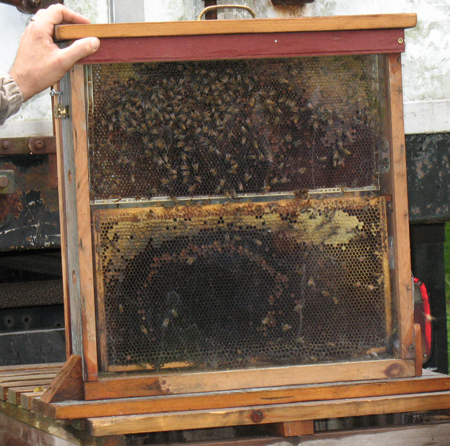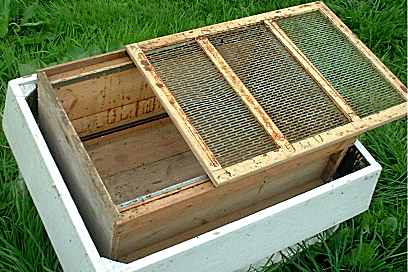Even though we had the threat of rain (heavy downpours while driving) and drizzle during the workshop, 15 farmers, interns and apprentices showed up at Two Gander Farm on July 17th, a muggy friday evening. The interns from Colchester Farm in MD drove about 3 hours, so hats off to these dedicated folks!
Trey Flemming farms 23 acres of leased property with his partner in Oley, Berks County, PA. He lives with his wife Deidre, in a lovely historic circa 1860 stone house on another 7.5 acres about 5 minutes away. In their second year of farming on 6 tillable acres here on the leased farm, he produces some vegetables for 3 farmers markets; Headhouse Market in Philly, Reading Terminal Market and Clark Park Market in the University City district. They also grow for a winter farmers market in 2 of their hoophouses and have a passive solar greenhouse, modeled after Steve Moore's plans.
Trey began the workshop by showing us a cutaway of a hive, with the brood's nest on the bottom, pollen in the middle with honey situated at the top. 80% of the bees are sexually inactive female workers, 10-20% are the male drones. While there is only one queen and she never leaves the nest, the bees function as one entity, they'll share food and pheromones. There can be from 30 - 50,000 bees in one colony, with just one queen. Trey uses the standard moveable frame Langstroth hive, invented by Philadelphia native, Reverend Lorenzo Langstroth, in 1851.
The queen bee moves from one box to another but usually remains in the lower 2 boxes in a tower. A 'Queen Excluder' wire mesh frame simply allows the worker bees to move but not the queen, since the mesh is smaller than she can fit through.
At any one time Trey has 60-65 hives. He keeps them in 7-8 different locations during the year. When bees begin the process of raising a new Queen, they swarm - usually here in southeastern PA, in April, May and June. The older queen, who can live up to 5 years, simply knows when to leave and half the worker bees follow her to perch on a tree or fencepost. They send out scouts to find a new home to raise their colony. If you position your boxes where you find a swarm, they'll move right into them and since a starter colony can run from $75 to $100, Trey suggests this is a great way to get new bees into your farming system. Because the bees have efficiently consumed as much honey as they can to resume making honeycomb in their new home, they are engorged, docile and easy to handle at this time. Most beekeepers replace their queens every 2 years, and Trey thinks that the most productive queens are 2 years old, laying more than 1000 eggs at her peak. He marks his queens depending on age, which allows him to keep track of which has been replaced and which may be getting ready to leave.
He can influence the genetics of a hive by producing more drones than workers. Most colony collapse can be traced to the Varroa mite, an external parasite that prefers to develop in the larvae of drone bees. Some ag schools are doing genetic research on influencing resistance to the mite. You can read about it here. Trey mentioned that larger beekeepers have more issues with collapse, simply because they are farming in monocultures, where beneficial insect populations have been reduced. Bees, like humans, need a diverse diet. Dandelion pollen is good for them early in the season for raising their brood, but after that it doesn't provide enough nutrients to sustain them. A varied food source will strengthen the hive's resistance to disease and increase the chance for their survival.
The small farmers aren't stressing their bees by shuttling them to distant pollination farms, and are using less pesticides than mono-cropped industrial farms. Scientists now suspect pesticides as another cause of colony collapse. Nicotinoids like Imidacloprid, lethal insecticides to honeybees, birds and beneficial insects like lacewings and spiny soldier bugs, have saturated the home growers markets since 1994. Like most registered pesticides, no studies have fully evaluated effects on both humans and the environment. Nicotinoids have been used to treat cotton and other crops, are systemic and are absorbed by the plant or tree, ultimately making their way into the bees' food sources. The colony builds up concentrations in their hives, disrupting mobility, navigation and feeding behaviors, eventually leading to complete collapse of the colony. Trey also warns against buying unknown honey to feed your bees, because of American Foulbrood disease, a devastating and contagious spore-forming bacterium.
He grows 3 acres of buckwheat and other flowers that attract beneficials and creates an attractive food product for bees. Buckwheat is fast growing, weed suppressing and a good cover crop. He'll mow it twice when it's seeding, lets it die back and tills under in the spring. He can get 3 successions in a year, since buckwheat breaks down quickly, unlike rye and vetch, which is harder to till under.
He also takes his bees to other neighboring farms for pollination and to collect free pollen from wildflowers, purple loosestrife, Japanese knotweed and other flowering plants. A lavender farm in Virginia nets him pollination fees and he sells the farmer honey at wholesale pricing. Bees usually stay within 1/2 mile of an area, but can travel up to 5 miles for nectar. Their two dances indicate direction but the 1/2 mile version is more accurate.
Bees slow down in the winter and the hive temperature drops to 65 degrees. In late February, it will rise again to 95 when the bees first leave after being cooped up all winter - they don't defecate inside the hive. He warns against hanging your laundry outside near a hive in early spring...
The last part of the workshop included a tour of Trey's home farm where he keeps about 11 colonies with 1 mating colony, collecting pollen every evening. We viewed his drying garlic hung from rafters in the stone barn and walked up to the back of his property where he plans to start a fruit orchard and where his beehives are kept. He offered interns the chance to use an uncapping knife to remove the bee cappings before putting the frames into his stainless steel motorized extractor. He has a trap that collects 60% of the pollen that his bees collect on their legs. It's a great nutritional source, builds antibodies and is used for allergies, although raw honey can be eaten with similar effects.
Particulates in honey cause crystallization and Trey strains his product. You can also submerge honey in a warm water bath to liquefy if it becomes crystallized over time. He noted that the propolis bees produce is their first line against pathogens. Taken predominately from pine trees, sap flows and other botanical sources, bees use it to make their hives more defensible by sealing off alternate entrances, and preventing any unwarranted small visitors, like dead mice or lizards from contaminating the hive. Anything too big to drag out, they seal in propolis, rendering the critter inert and harmless.
The best part of the tour had us all sampling Trey's marvelous clear black locust honey, his dark and smokey buckwheat honey and a tasty wildflower variety. His wife makes salves and lip balm from the beeswax and he'll make a few candles from it too.
Many thanks to Trey for his wonderful tour and knowledge of the most necessary of farming's creatures, and for everyone's continued attendance!
Next SAITA workshop on Vegetable Cultivation Techniques is Saturday July 25th from 11am-1pm at Quiet Creek Farm at the Rodale Institute in Kutztown, PA.
Happy growing! See schedule and addresses for workshops here.
Victoria Webb
SAITA Coordinator
vic@furiousdreams.com








No comments:
Post a Comment